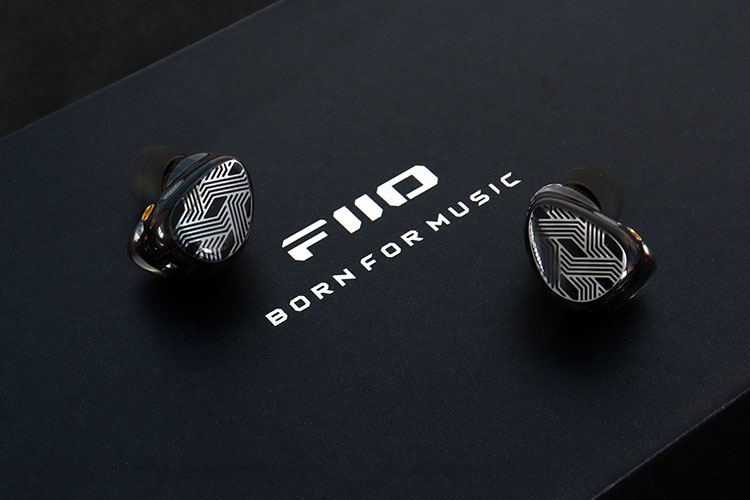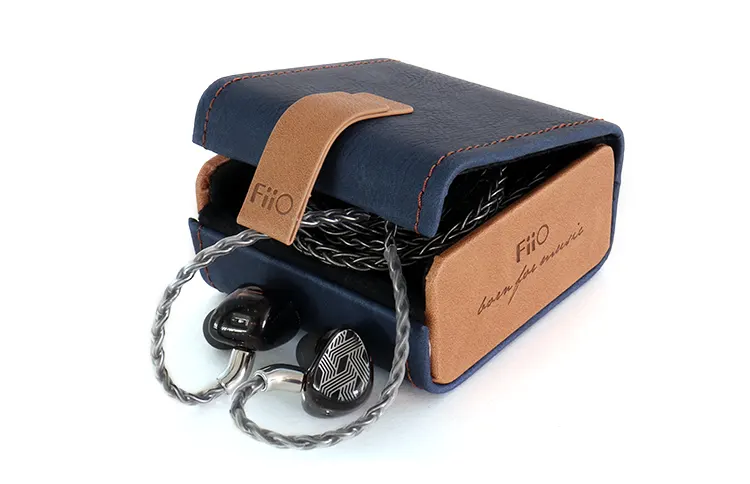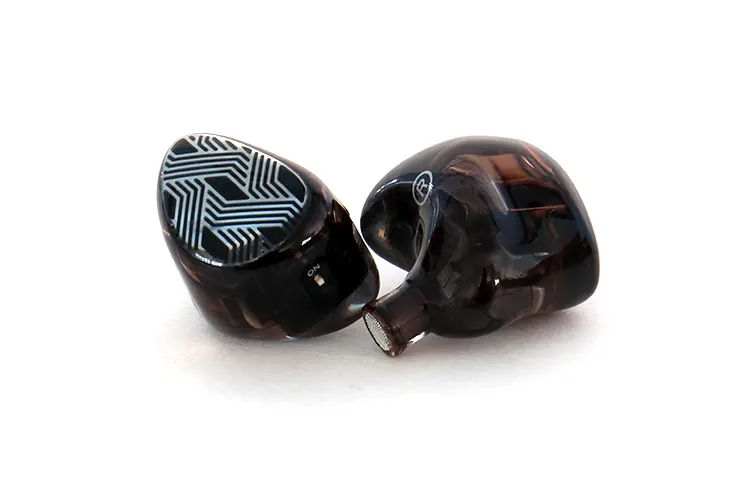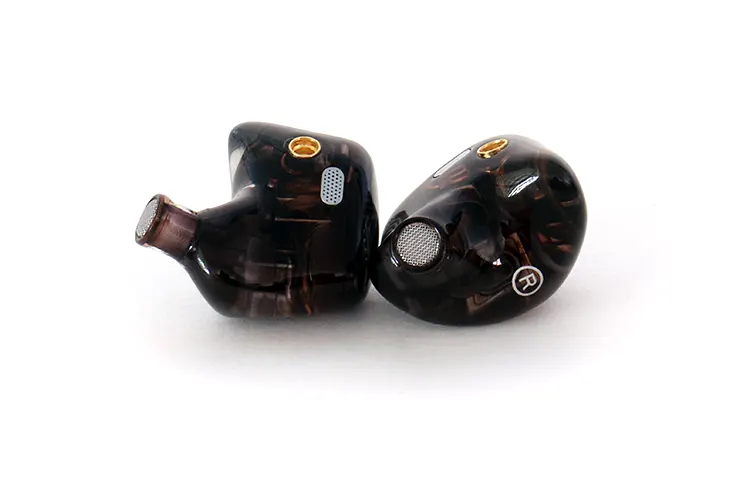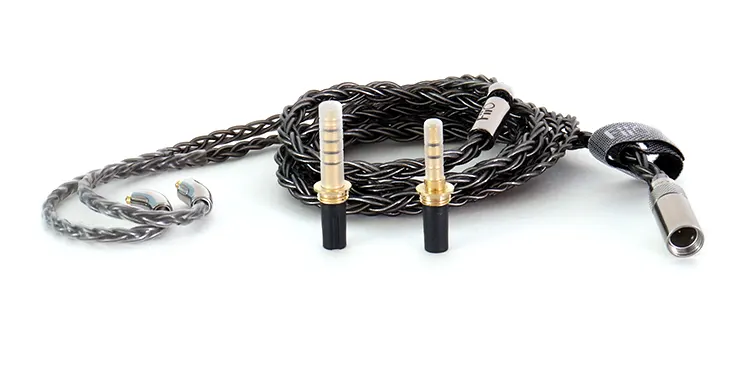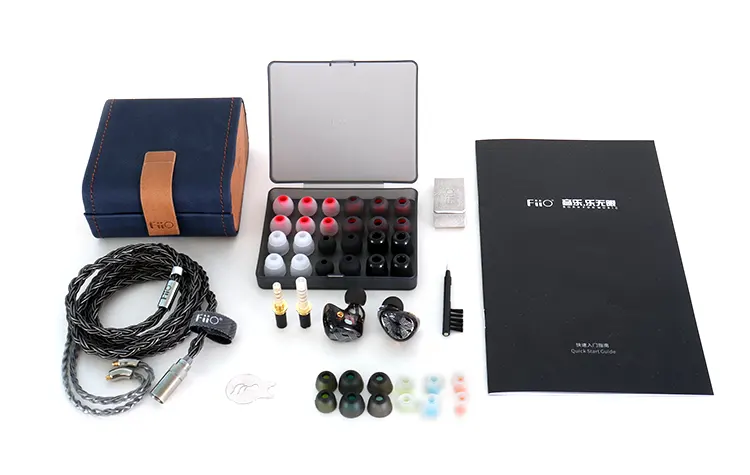Today, Louis reviews the FiiO FA19, which is a new flagship all-BA 10 driver universal in-ear monitor complete with switchable tuning capability. It is priced at $999.99.
Disclaimer: This was sent to me as a sample in exchange for my honest opinion. Headfonics is an independent website with no affiliate links or services. I thank FiiO for its support.
You can click here to learn more about the FiiO audio products we have previously covered on Headfonics.
Note, that this post follows our current scoring guidelines which you can read in more detail here.
FiiO has one of the largest selections of headgear out there and If you count up FiiO’s IEM and headphone lineup alone, you will find a total of 28 models up to date. However, FiiO has never touched the $1k segment until now with the recently released FA19.
The FA19 is a 10-driver all-balanced armature IEM priced at an SRP of $999.99. It is an IEM that attempts to elevate the BA driver to compete against dynamic drivers in their strongest categories, sonically speaking.
The FA19 is not just an upgrade to the all-BA driver 3rd generation FA9, it’s a next-level IEM according to FiiO.
It’s an interesting launch indeed and FiiO usually makes products that punch above their price tier so it’s nice to see what they can do at this price point. It’s an advanced IEM indeed.
Features
Driver configuration
The FA19 uses an all-Knowles 10 Balanced Armature driver array. The driver count is calculated by adding each internal driver within each composite BA driver module.
There are two next-generation bass modules with two individual armature drivers within each armature module, giving you a total of four BA bass drivers. The high-frequency array follows suit with four drivers while the midrange driver count is at 2.
FiiO paid particular attention to the FA19’s bass tuning to obtain the characteristics of a good dynamic driver while retaining the best traits of BA drivers.
One innovation FiiO and Knowles ventured into was to open up the rear cavity vents of the BA bass drivers to increase their diaphragm amplitude and that translated into a gain of a few extra undistorted decibels on the low end.
Alongside the bass drivers are two custom ED BA composite drivers on midrange and treble tasks. The only off-the-shelf driver variants used inside the FA19 are the two SWKF-31736 BA drivers, responsible for ultra-high frequency reproduction.
Internal Acoustic Features
FiiO crammed the FA19 with so many proprietary ideas that I don’t know where to start. We’ll condense a bit because FiiO incorporated some of their new and some old, patented designs that claim sonic improvements and it would take a while to explain each in detail.
Their legacy S Turbo design was implemented alongside a new Negative Feedback bass enhancement system that works with the drivers to reduce resonant frequencies and promotes better driver motion control overall.
The inner shell plays a part in the sonic signature and was designed to further reduce resonances by expelling them through a rear chamber. It seems that lots of effort went into ensuring a natural timbre was produced within this set.
To further that objective, FiiO also incorporated a HiFi mid-frequency notch filter that improves the midrange. This filter reduces resonances and allows the drivers to naturally cancel out the unwanted production of frequencies beyond the driver’s crossover points.
Design
FiiO claims that the FA19 has the smallest 10-driver internal cavity of any IEM up to date. However, it’s a full-sized IEM nonetheless and is not what I would consider a mini-shell design. Their weight is kept at a low 7g apiece.
The FA19’s shell design seems to have inherited similar idiosyncrasies to the FX15’s build. However, the color scheme was changed to a black resin with grey accents. The shells are polished until they feel like butter in your hands. These IEMs have a very smooth finish.
The resin’s black color according to FiiO is achieved by using biological dyes and a gold-embedded coloring process which emits the color from the inside and the color comes from within the cavity where the drivers are mounted.
The only other visible implementations on these shells are some small silver grates that I assume are the driver vents. The other visible implementations are the silver output nozzle screens and the micro-switches which are mounted on the top inner side of the shells.
Mini switch
The FA19 uses a flush-mounted two-position microswitch that offers the user access to the two distinct sound signatures. One is labeled as a Monitor mode and the other a Music mode.
My most common question when it comes to switches that change the overall sonic character is that the maker must supply two usable sonic signatures and in this case, the off position is my favorite, but the other, not so much.
The on position has a 3 dB bass boost that somehow manages to veil other frequencies in my opinion, particularly the high frequencies. The high frequencies on this setting no longer present themselves as sharp, focused, and most of all, present since their output seemed considerably reduced.
The off position brings out the high frequencies and also tightens up the bass response and improves bass control.
FiiO’s graphs show a reduction in bass output for the on switch. However, I found the high frequencies were too afflicted by this change. So, this feature is switched off for the remaining part of this review.
Comfort and Isolation
The FA19’s shape is based on a universal fit IEM shape and it should be comfortable to wear for most, it was for me. Their design snugly fits average ears like mine, and they rarely move around. They stay put, especially when combined with the cable ear hooks.
Their comfort level is high but I’m not sure if the seal between the ear and the FA19 shell is perfect. This IEM does isolate but only up to a certain level and I doubt the noise suppression surpasses 22 decibels.
Ear Tips
I’m a traditionalist when it comes to IEM tips and never grew out of the plain vanilla black rubber variants and it seems I’ve gotten accustomed to them to the point where I use no other tips most times. They sound the best to me.
It doesn’t matter much if it’s a wide-bore or not with the FA19 and what matters most is to get the output nozzle tip as far as it can go into the ear canal. That gave me the best results. So, I wouldn’t say they’re tip-sensitive as long as you adhere to that rule.
A good example is when I used the FiiO FA19 with foam tips, the bass lost some impactfulness and body. I was unable to get the output nozzle tip close enough to the inner ear with these tips and it made the overall sonic presentation sound wider but it simultaneously lost intimacy and sounded too pallid.
The best in comfort is the FiiO HS18 tips hands down. They’re also the closest sonically to the rubber tips compared to the other included tips including the silicon tips. Their comfort level is increased due to their compliance inside the ear canal.
A bass-enhancing tip? No thanks. These IEMs can handle a bass boost but get to a point where the bass loses control and becomes unstable. This is not a bass-head IEM, I would consider it a refined listen and more monitor-like.
Stock Cable
The FiiO FA19 stock cable is their LC-RD Pro cable assembly minus one connectivity option. The cable is an 8-wire Litz braid made with 224 isolated strands of German TPU-shielded high-purity silver wire.
The connectors are made from FiiO-branded stainless steel including the MMCX connectors, centerpiece, and the input connector.
The best part of this cable, or the most versatile aspect is FiiO’s interchangeable tip system. FiiO throws in the box a 3.5mm single-ended tip plus a 4.4mm but omits the 2.5mm tip giving you two choices instead of three that come with the retail packaged LC-RD Pro cable.
I prefer the secure 0.78mm dual pin connectors but I’ve never had an issue with FiiO’s MMCX connectors and FiiO seems to use top-notch components, including their connectors.
The assembly also produces very little microphonics, and although it’s an eight-cable braid, it seems flexible and pliable, preferred over a stiff cable.
Packaging & Accessories
To start, FiiO includes 18 tip sets in total. Amongst them are some Spin Fits, HS18 tips, balanced ear tips which were my favorites, foam tips, bass tips, silicon tips, and two that seem to be another silicon variant.
The rest of the accessories are the storage case, the cable clip, an MMCX removal tool, and literature. We already mentioned that the FiiO FA19 comes with their LC-RD Pro cable assembly plus two tips. The accessories inclusion is generous here.
The box and packaging, however, don’t shout flagship nor is it up to the level of other manufacturers’ $1k IEMs. However, credit is given to FiiO because the packaging has been reduced in size comparatively to their previous models and the overall packaging seems more efficient.
Sound Impressions
I used the FiiO FA19 with the tone switches in the off position which is the studio option and I avoided any type of signal processing during listening tests.
I used gear like the FiiO KA17 dongle, the SMSL SU-X, and the SH-X stack. I also used iFi Audio’s xDSD Gryphon, the GO Bar Kensei, and FiiO’s Q11 portable DAC amplifier.
Summary
I’m going to label the FiiO FA19 as their monitor IEM, not because of the feature’s label but because they are excellent for that. They are more neutral with a delicate side and not as aggressively tuned as other FiiO IEMs.
I was expecting an overall monstrous forward character since there are 10 drivers per side but they’re quite gentle and restrained. They also can be considered highly controlled, coherent, and technically capable.
They portray common BA characters but the bass response within this IEM was considered an important aspect of the overall sound signature here and was tuned to assimilate a dynamic driver to some degree and they did succeed.
Bass
The FiiO FA19 bass response is ample enough for me on a neutral setting and test bed and I like lots of bass energy which is supplied here in spades. These produce fast-responding deep notes with a very good bass note distinction.
These BA bass drivers have some dynamic driver characteristics, presenting bass with plenty of energy behind every note. One could easily be fooled into thinking that their impactfulness can only be produced by a dynamic driver.
The bass is plentiful in body and quantity. I do not recommend bass boosting or increasing these IEM’s bass response utilizing signal processing by no more than 3 decibels.
These IEMs produce some of the best bass of any FiiO IEM to date. I have the FH9, the FD7, and the FX15 and I prefer the bass produced by the FA19 in every case.
Midrange
The FA19 midrange is tamed and well-controlled. It’s a soft-mannered midrange that rarely gets shouty.
I can go through several songs that have a high presence of Saxophone riffs and Trumpet sections that would make any IEM sound too intense and the FA19 handles these tracks by displaying restraint.
Their overall tonality is natural. Female vocals sound realistic but male vocals on some recordings can take on a deep character and at times can sound too deep-toned. This IEM does best with wind instruments. In this area, the tonality is as natural as can be.
There seems to be a dip in the midrange that starts early and doesn’t rise in output until it reaches 1k or 1.5k. Does this give the FA19 a V-shaped output? The answer is no. The overall signature is a balanced one.
The midrange overall is full-bodied but a touch timid. I prefer this over an IEM with lots of midrange energy because you’re spared from shrillness, and piercing effects. All the details are retained and this shyness doesn’t veil the overall presentation.
Treble
The treble is nicely done with good clarity but it can get strident at times under certain conditions. The remedy would be to simply switch the microswitches to the on position because that tuning option displays a reduced output in that area of around a couple of decibels.
In the off position, the high frequencies are vividly presented and come across with enough energy to distinguish every high note.
My thought process does veer me to the decision of FiiO using off-the-shelf-tweeters here and reminds me of my previous FiiO review observations.
The FH7, for example, used an SWFK31736 BA tweeter and FiiO said specifically that it was an improvement over the 30017 drivers, but then used the 30017 on their following release, the FH5s.
That was my only dislike of the FH5s, the average-sounding high frequencies but it was probably done due to availability restrictions at the time.
I’m unsure why Sonion tweeters were not used here after they were used successfully within the FX15, for example. Do the FA19s have enjoyable highs? You bet. But my expectation was high, no pun intended, and I was expecting spectacular, but all I got was great highs, not spectacular.
Staging & Dynamics
The FiiO FA19 has interesting characteristics in its soundstage in that most IEMs do certain things in other ways.
I would consider the overall soundstage of the FiiO FA19 to be personal-sized, with lots of width, but not much height at all. Depth is not hindered and is ample since the perception one gets has wide expansiveness.
The center stage projects within the line of sight but with excellent placement. Imaging is spot-on maintaining coherence between the two earpieces well and placing cues anywhere within the center plane.
I just wished there was more balance between the amount of width and height or simply put, more height, period.
One can hear distinct micro-placement on both sides of the ears for days and the center stage paints a clear image of where things are up front. There’s lots of technical ability but it remains within a horizontal plane.
Click on page 2 below for my recommended pairings and selected comparisons.

